In the realm of interior design and construction, the choice of cladding material significantly influences both the aesthetic appeal and environmental impact of a structure.
Traditional materials such as wood, vinyl, metal and natural stone cladding have long been favoured, but as sustainability gains precedence in the construction industry, innovative and eco-friendly cladding alternatives are now in high demand.
In this comprehensive guide for the best alternatives, we delve into a whole host of cladding options, exploring sustainability benefits, cost, unique features, and aesthetic qualities.
Table of Contents
Summary Comparison Table
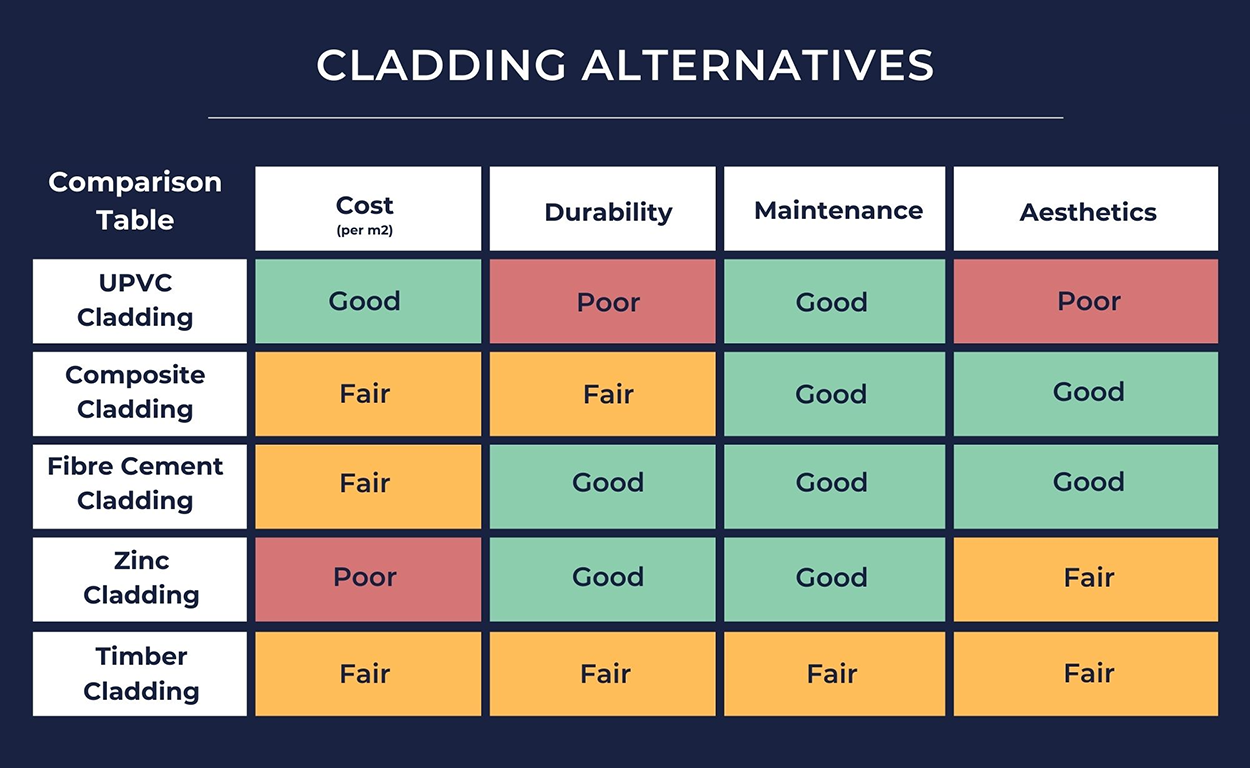
The Overview
Timber cladding refers to the application of wooden panels or boards to the exterior of a building to enhance both its aesthetic appeal and protection against the elements. Commonly used types of wood for cladding include cedar, redwood, pine, and oak. Other less commonly used types of wood include Douglas Fir and Siberian Larch.
The cladding is most appreciated for its natural beauty, warmth, and the character it adds to a structure. It can be applied vertically, horizontally, or in various patterns to achieve different visual effects.
However, it is important to remember that timber is extremely flammable and does not provide fire protection as others might do.
Reasons to Seek Alternative Materials
While timber cladding has its advantages, there are several reasons why someone might consider alternative materials for those looking to add exterior cladding to their home:
Cost: High-quality wood can be expensive per square metre, both in terms of material costs and maintenance. Some alternatives provide a more budget-friendly option for achieving a similar aesthetic, providing the woodgrain texture without breaking the bank.
Maintenance: Timber cladding, unlike brick cladding or composite, requires regular maintenance, including staining, sealing and/or painting, to preserve its appearance and protect it from the elements. Some homeowners prefer alternatives that demand less upkeep.
Durability: Although a durable cladding material, timber can be susceptible to issues such as rot, insects, and warping over time. Alternatives like composite material, brick or certain metals may offer enhanced resistance to these concerns, making them a wonderful option for agricultural buildings.
Environmental Concerns: Sustainable forestry practices are essential for mitigating the environmental impact of timber production. Some individuals may seek alternatives that are made from recycled materials or have a lower environmental footprint. Looking for any certifications or logos surrounding the product such as FSC is a great place to start.
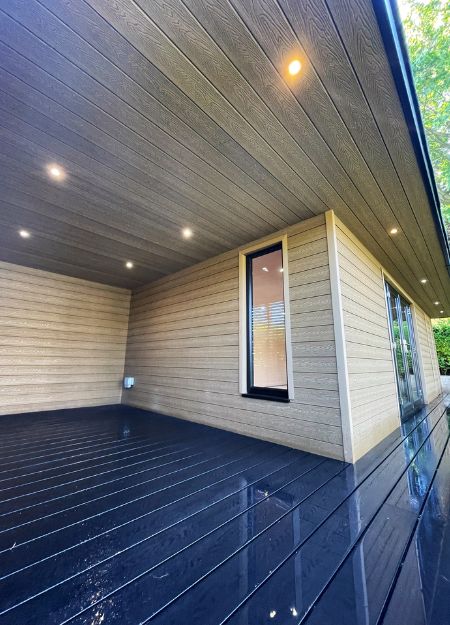
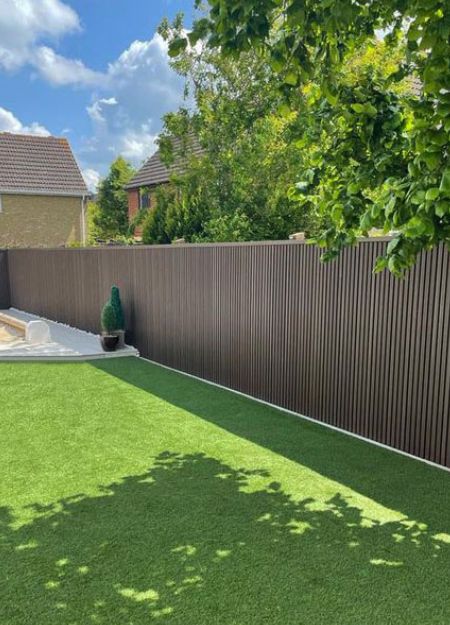
Variety of Finishes: Timber cladding offers a unique and natural look, however, alternatives like composite materials provide a broader range of finishes, textures and colours. This variety allows for more diverse design possibilities.
Fire Resistance: In areas prone to wildfires, or for buildings with strict fire safety regulations, materials with higher fire resistance such as metal, stone or certain composite are the safest options. Be sure to check for a fire rating.
Innovative Design: For those looking to push the parameters of architectural design, alternative materials like glass, bricks, metal, or modern composites can provide a contemporary and innovative aesthetic that may not be achievable with traditional timber. Known for its industrial aesthetic, cladding adds a modern and edgy appearance to your home's exterior, making a bold design statement.
Weight and Installation Ease: Some alternative exterior cladding options are easier to install than timber, making them a practical choice for certain construction projects. Additionally, some exterior cladding materials weigh more than others and may require extra support.
Cost: High-quality wood can be expensive per square metre, both in terms of material costs and maintenance. Some alternatives provide a more budget-friendly option for achieving a similar aesthetic, providing the woodgrain texture without breaking the bank.
Maintenance: Timber cladding, unlike brick cladding or composite, requires regular maintenance, including staining, sealing and/or painting, to preserve its appearance and protect it from the elements. Some homeowners prefer alternatives that demand less upkeep.
Durability: Although a durable cladding material, timber can be susceptible to issues such as rot, insects, and warping over time. Alternatives like composite material, brick or certain metals may offer enhanced resistance to these concerns, making them a wonderful option for agricultural buildings.
Environmental Concerns: Sustainable forestry practices are essential for mitigating the environmental impact of timber production. Some individuals may seek alternatives that are made from recycled materials or have a lower environmental footprint. Looking for any certifications or logos surrounding the product such as FSC is a great place to start.


Variety of Finishes: Timber cladding offers a unique and natural look, however, alternatives like composite materials provide a broader range of finishes, textures and colours. This variety allows for more diverse design possibilities.
Fire Resistance: In areas prone to wildfires, or for buildings with strict fire safety regulations, materials with higher fire resistance such as metal, stone or certain composite are the safest options. Be sure to check for a fire rating.
Innovative Design: For those looking to push the parameters of architectural design, alternative materials like glass, bricks, metal, or modern composites can provide a contemporary and innovative aesthetic that may not be achievable with traditional timber. Known for its industrial aesthetic, cladding adds a modern and edgy appearance to your home's exterior, making a bold design statement.
Weight and Installation Ease: Some alternative exterior cladding options are easier to install than timber, making them a practical choice for certain construction projects. Additionally, some exterior cladding materials weigh more than others and may require extra support.
Popular Alternatives to Timber Cladding
-
Composite Cladding
-
Fibre Cement Cladding
-
Vinyl Cladding
-
Metal Cladding
-
Concrete Cladding
Cost Effectiveness
Composite Cladding
Composite cladding, whilst initially more expensive, is actually cost-effective in the long run. Being extremely low maintenance and made of high-quality materials, composite cladding provides a modern appearance without the costly upkeep.
Fibre Cement Cladding
Fibre cement wall cladding is a budget-friendly alternative that combines the strength of cement with the versatility of wood. One of the key advantages is its low maintenance requirements, making it an economical choice over the long term.
It is worth noting the cost of labour is generally higher for the installation of fibre cement cladding.
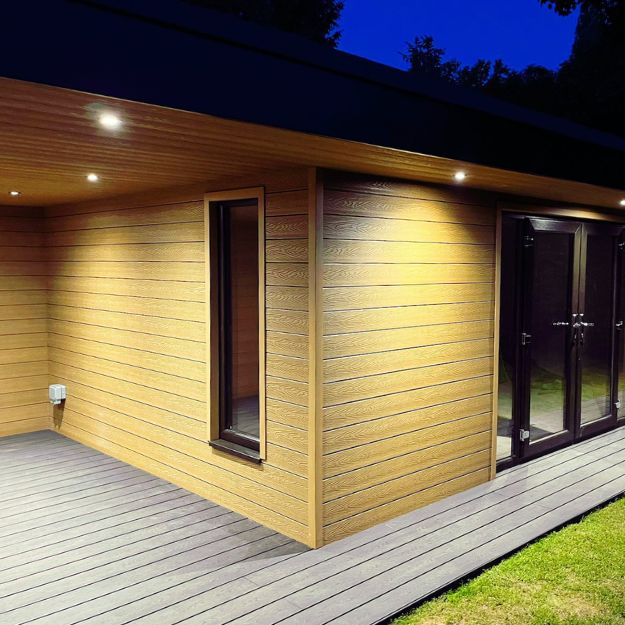
Vinyl Cladding
Vinyl cladding is a cost-effective solution that mimics the look of traditional wood without the associated expenses. It is one of the most budget-friendly options available and is a great option if you are looking for cladding material that lasts.
Metal Cladding
Metal wall cladding, such as steel or aluminium, can be an economical alternative to timber. It offers a sleek and modern appearance that can enhance the visual appeal of your exterior walls. Known for its resistance to the elements, metal cladding provides a cost-effective solution that requires minimal maintenance.
Concrete Cladding
Concrete exterior cladding is a budget-friendly option that adds an industrial aesthetic to your home. It is often less expensive than traditional timber and can be moulded into various textures and styles.
Additionally, concrete has excellent thermal mass properties including thermal insulation, contributing to energy efficiency and potentially reducing long-term heating and cooling costs.
Durability and Longevity
Composite Cladding
Comprised of plastic and wood fibres, composite is well-known for its durability. Compared to wood cladding which is susceptible to both rotting and splintering, composite materials tend to be both rot and splinter resistant and have an average lifespan of up to 25 years.
Fibre Cement Cladding
This type of cladding, constructed of cellulose fibres in the manufacturing process, is one of only a few that can really withstand all weathers. Often, salty, dry or humid air can affect properties, particularly within the cladding.
Working as a protective barrier, fibre cement avoids costly cons such as cracking, fading or warping. What's more, it has an average lifespan of up to 40-50 years.
Vinyl Cladding
Vinyl is known for its resistance to weathering, providing a long-lasting cladding solution that won't break the bank. Unlike other cladding materials, it won't crack, fade or rot and is one of the most durable materials around and can have a lifespan of up to 60 years or more.
Metal Cladding
When it comes to cladding, there is none more highly durable than metal. Not only is metal cladding incredibly strong, it is also resistant to water damage, corrosion and electrochemical reactions. Overall, metal cladding has the longest lifespan of all, but it is important to note that there are a few cons too.
These include:
-
Rust (when scratched)
-
Chalking
-
Colour fading
-
Delamination
Concrete Cladding Material
Like the other house cladding materials mentioned above, concrete cladding is resistant to water and rotting and is fire resistant. So, what else is new? Given the strength and integrity of concrete, the material is also crack-proof, low-maintenance and an excellent choice for large scale projects.
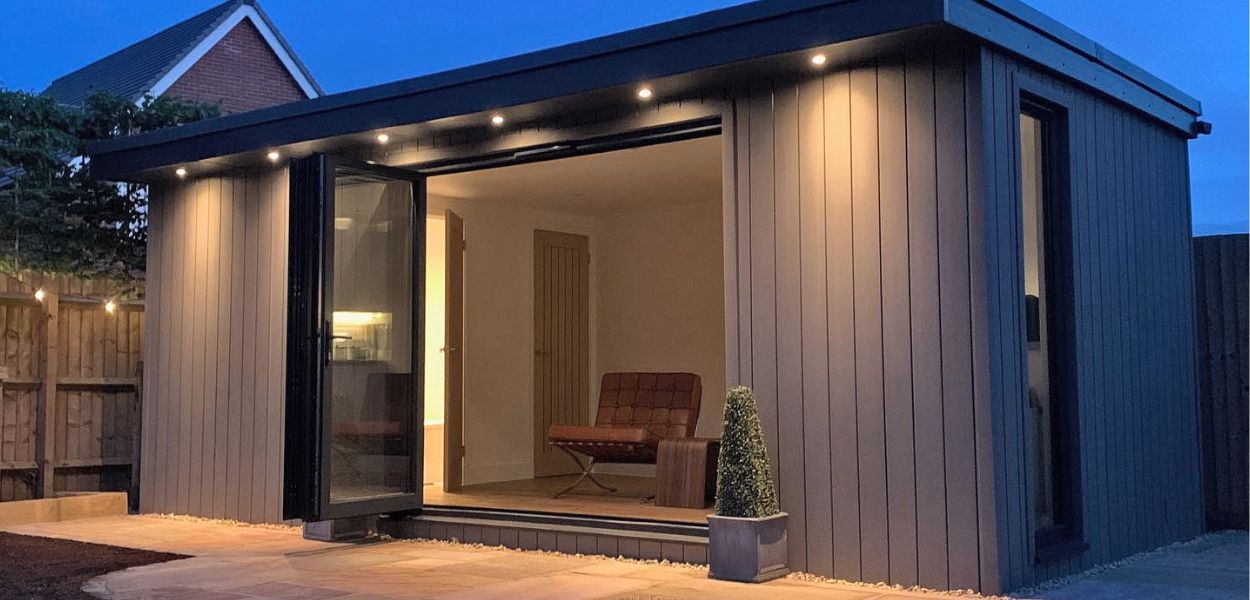
Sustainable Options
Although timber cladding is a natural material, the process of extracting the timber from its habitat is not considered a sustainable one.
The same can be said for the environmental footprint associated with metal production.
With a mass of air emissions, furnace fumes, oil mist and dust released throughout the process, opting for recycled or repurposed metal for external cladding, like corrugated metal, is a much more sustainable choice.
It is worth noting that although metal cladding panels are the most durable of all, the above factors should be carefully considered when looking to make a purchase.
If sustainability is what you are looking for, then composite cladding is king. A key advantage of this type is that it's an environmentally-friendly alternative to timber cladding. Comprised of both recycled plastic and natural materials (wood), the materials are ethically sourced and prevent plastics from unnecessarily entering the landfill.
Additionally, the unique composition means the material is resistant to many elements including:
-
Wind
-
Rain
-
Salty Air
-
Humid Climates
-
Freezing Climates
This makes composite cladding the best option for those looking to invigorate their space, whilst protecting the environment from further damage.
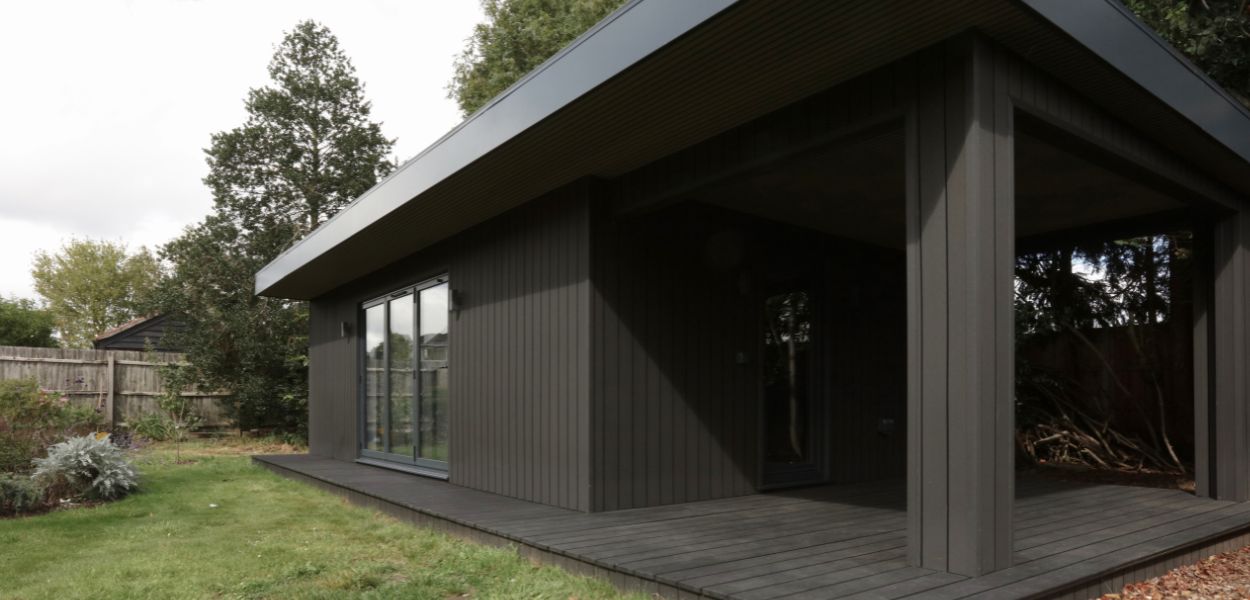
Technical Aspects and Installation
Installing cladding materials involves particular processes depending on the material chosen. Each comes with its own level of complexity and suitability for DIY projects versus professional installation.
Here, we'll compare the installation processes.
Composite cladding offers a blend of natural aesthetics and enhanced durability. The installation process for composite cladding shares similarities with both wood and plastic-based materials, making it moderately DIY-friendly depending on the specific product and project requirements.
While DIY installation is feasible for composite wall cladding, homeowners should still follow manufacturer guidelines and best practices to achieve optimal results and longevity.
Metal cladding offers sleek, modern aesthetics and exceptional strength that's suitable for various architectural styles and climates. The installation process often requires specialised tools and techniques due to the material's susceptibility to denting or scratching during handling and installation.
While DIY installation of metal cladding is possible for skilled individuals, it may be more challenging and time-consuming due to large panels when compared to other cladding materials. This makes professional installation a preferred option for many projects.
Vinyl cladding panels often considered one of the most DIY-friendly cladding options. Its lightweight nature, interlocking panels, and straightforward installation methods make it accessible to homeowners with basic carpentry skills. The process typically involves measuring and cutting the siding panels to fit the wall surface, securing them with nails or clips, and adding finishing touches like corner pieces and trim.
While DIY installation is feasible for vinyl siding, ensuring proper alignment, levelling, and weatherproofing requires attention to detail to prevent water infiltration and maintain structural integrity.
Fibre cement, known for being low maintenance, offers a more challenging installation pared to vinyl cladding. Due to its heavier weight and specialised cutting requirements, fibre cement installation often requires professional expertise to ensure precise fitting and secure attachment.
Additionally, fibre cement installation may involve handling silica dust, requiring appropriate safety measures and equipment, making it better suited for experienced installers familiar with safety protocols and manufacturer guidelines.
Natural wood cladding offers a timeless aesthetic and versatility but demands careful attention to installation due to the wood's susceptibility to moisture and decay.
While DIY installation of wood cladding is feasible for experienced homeowners with woodworking skills, it requires meticulous surface preparation, sealing or staining. This also includes precise attachment methods to mitigate potential issues like warping, rotting, and insect infestation.
Professional installers are often recommended for wood cladding projects, especially for larger-scale installations or complex designs.
In summary, the suitability of cladding materials for DIY versus professional installation varies based on factors such as material characteristics, installation complexity, and homeowner expertise.
Real-Life Case Studies and Examples
Rooke Construction (below) has taken remote working to the next level with this stunning garden office. Nestled in natural surroundings, the increased durability and weather resistance make this Black Fibre Cement Cladding the perfect choice.
Paired with our low-slip and rot-resistant Composite Decking Boards in Charcoal, this idyllic space is fit for a productive working day.
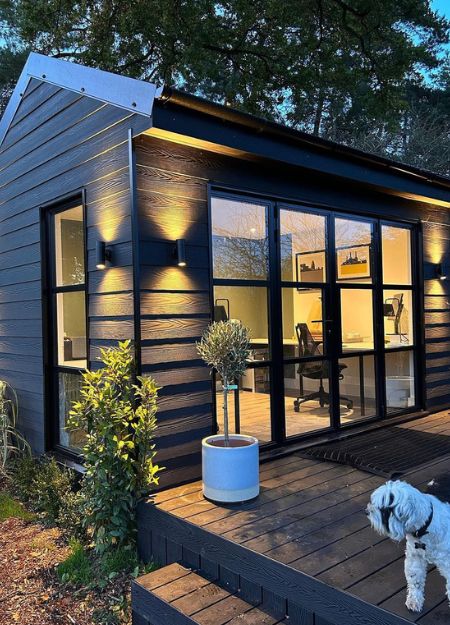

This incredible large-scale project (above) known as "The Spinney" by Jamie Ware Building has used Cladco Woodgrain Composite Boards in Charcoal, to create this high-quality Cladding Design.
The dark, inky tones of the property have been brought to life with contrasting pops of colour from the hanging floral baskets and surrounding green foliage.
Rooke Construction (below) has taken remote working to the next level with this stunning garden office. Nestled in natural surroundings, the increased durability and weather resistance make this Black Fibre Cement Cladding the perfect choice.
Paired with our low-slip and rot-resistant Composite Decking Boards in Charcoal, this idyllic space is fit for a productive working day.


This incredible large-scale project (above) known as "The Spinney" by Jamie Ware Building has used Cladco Woodgrain Composite Boards in Charcoal, to create this high-quality Cladding Design.
The dark, inky tones of the property have been brought to life with contrasting pops of colour from the hanging floral baskets and surrounding green foliage.
This home's kerb appeal has been greatly increased with the help of Cladco Fibre Cement Wall Cladding Boards in Cream.
Each 3.66m Fibre Cement Board features authentic woodgrain detailing installed horizontally using a feather board effect. Boards overlap to produce an attractive exterior design and are available in eight colours and unpainted.

Conclusion
In the search for sustainable and eye-catching cladding alternatives for the next project, homeowners have a range of colours and finishes to choose from. Whether you prioritise the repurposing of recycled plastics, the strength of fibre cement, the transparency of glass, or the industrial chic of corrugated metal, each material brings its unique set of benefits to the table.
By incorporating sustainable cladding options into your home design, you not only elevate its aesthetic appeal but also contribute to the ongoing efforts towards a greener and more environmentally responsible future.
